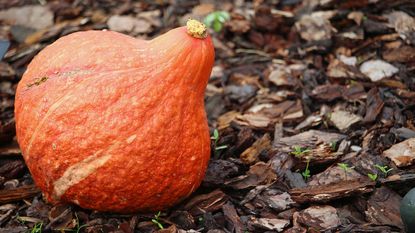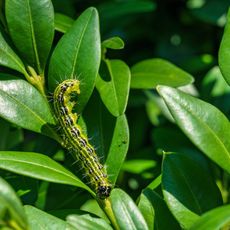History Of Golden Hubbard Squash


Golden Hubbard squash is an attractive winter squash with a tear-drop shape and a deep orange-red or golden-red shell. The innards of this squash are golden-yellow, with a mild flavor and sweetness that exceeds most varieties of Hubbard squash. Ready to learn more? Me too.
History of Golden Hubbard Squash
Hubbard squash (Cucurbita maxima) originated in the West Indies or South America, and was introduced commercially in the United States in the late 1840s, where it became popular on the scene a few years later. The history of Golden Hubbard squash extends to the middle part of the nineteenth century, and we can thank J.J. Harrison of Storrs & Harrison, a small nursery in Lake County, Ohio, for developing the sport plant. The D.M. Ferry Company, later to become the familiar Ferry-Morse company, offered the squash to the public in 1898. Golden Hubbard garnered good reviews and a 1906 seed catalog pronounced it, "extra fine quality" - and indeed it is.
Growing Golden Hubbard Squash
Growing this heirloom squash isn't difficult. Like other types of winter squash, Golden Hubbard is a prolific producer that requires only a patch of well-drained soil and plenty of sunshine. But don't rush to plant it, as squash is highly susceptible to frost, in spite of its being deemed "winter" squash. You'll need to wait until the soil is at least 65 F (18 C).
Winter squash likes rich soil, so dig in a few inches of compost or manure and a small amount of balanced garden fertilizer before you plant. Direct sow the seeds about 2 inches in mounds with 4 to 6 seeds in each mound. Allow about 4 feet between these hills. Water daily for the first week - providing just enough water to keep the soil slightly moist. Thin the seedlings to two plants per mound once the seedlings have two leaves, not counting the initial seedling leaves.
Once the plants are established, deep, infrequent watering that soaks the top 6 to 8 inches of soil is best. As a general rule, provide 1 to 2 inches of water per week. Use a drip system or soaker hose to keep the leaves dry, if possible. Damp leaves increase the risk of rot and other fungal problems associated with wet soil.
Squash doesn't require a lot of fertilizer, but the plants benefit from a light feeding with an all-purpose fertilizer when the seedlings are a few inches tall. Sprinkle dry fertilizer along the side of the plants, then water deeply. Fertilize a final time soon after blossoms appear. Your squash should be ready to harvest in late fall once the vines begin to peel back.
While Golden Hubbard squash is often used for canning or decoration, it's also an excellent keeper. In most cases, heirloom varieties of Hubbard squash will keep up to 110 days after harvesting.
Gardening tips, videos, info and more delivered right to your inbox!
Sign up for the Gardening Know How newsletter today and receive a free download of our most popular eBook "How to Grow Delicious Tomatoes."

A Credentialed Garden Writer, Mary H. Dyer was with Gardening Know How in the very beginning, publishing articles as early as 2007.
-
 Urban Composting Guide: How To Compost In The Middle Of The City
Urban Composting Guide: How To Compost In The Middle Of The CityUrban composting does not have to be daunting. You can compost in the city, and maybe even try some urban worm composting!
By Mary Ellen Ellis
-
 Shrub Diseases And Pests To Watch Out For
Shrub Diseases And Pests To Watch Out ForShrub diseases and pests can be challenging. Learn how to recognize and eradicate them before they can present a danger to your plants.
By Susan Albert